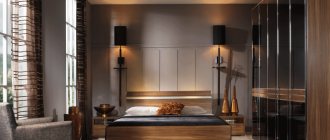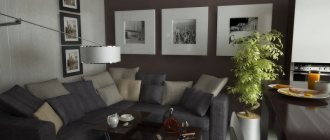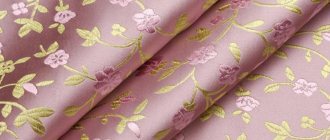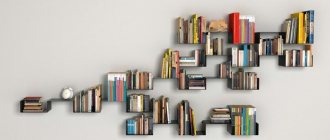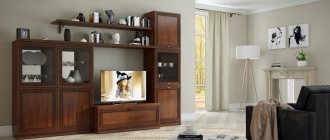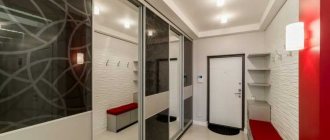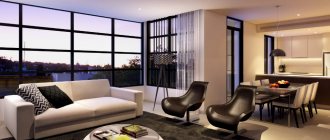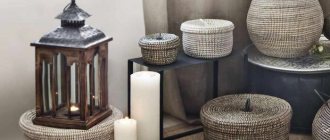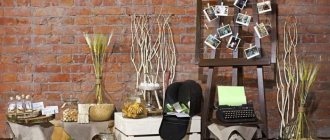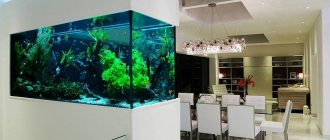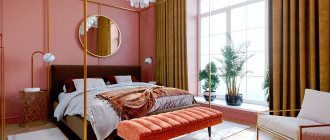12/26/2020 Read in 6 minutes.
You can see the most beautiful solutions in the design of wall moldings in interior design in our new article. We have prepared for you examples with polyurethane and plaster, metal and brass moldings for walls. The design projects and renovations of apartments in Moscow presented in the article were carried out by specialists from the Fundament Group of Companies.
What are moldings and what are they like?
Molding is a decorative strip of convex or concave shape. It is used for decoration, harmonization of interiors, visual correction of room defects. Moldings can be narrow - a couple of centimeters wide, and wide - up to 20 cm. They are used for interior and exterior decoration, and can be rigid or flexible. They come with a longitudinal relief (most often), with floral or geometric patterns.
Depending on the installation location, moldings can be ceiling, wall, or corner. Corner ones are usually placed at the junction of the wall and ceiling. Moldings are made from:
- Foam plastic. The cheapest. They have a slightly loose surface, so they are only suitable for puttying and painting. Attached to a flat wall using glue.
Moldings in the living room interior are a very common type of decor. - Polyurethane. More expensive, dense, with a smooth surface. They also stick to walls and ceilings.
- Plastic. Smooth with a shiny surface. They wash well, have a long service life, but are not combined with all materials and are not suitable for all interiors.
- Plaster. Heavier ones are made by casting. Massive elements are attached with nails or self-tapping screws, thinner ones can be glued with a special adhesive composition.
- Wood. Wooden moldings are attached to finishing nails or regular nails without heads. Gluing with wood glue is possible. Fits well into classic, Scandinavian, Russian interiors. All those in which wood trim or decorative items are present in one form or another. Only a small part of the options with patterns
- Metal. They are very durable, but metal moldings can only be used in interiors of a certain type - minimalism, hi-tech, loft.
- Polymer flexible. Polymer flexible moldings are used to decorate columns and rounded walls. They are attached with glue.
Plaster moldings appeared in ancient times. They became the model by which decorative strips for interior decoration were created from more modern and cheaper materials - foam plastic and polyurethane.
Types of moldings
The modern market can become a huge assortment of stucco moldings for decorating walls, ceilings, floors and other surfaces. Types of moldings differ in appearance, in quality of operation, and also, depending on this, in the design of certain preference plans.
Ceiling
Ceiling moldings - baseboards; This type of decorative planes is most widely used in individual work, everyday life and sleep. The baseboard is used as a separate “rosette” at the boundary between the ceiling and the wall to complete the geometric design and production of visual aids.
Like all moldings, ceilings are divided into simple and complex. The first are presented in standard low-versions with minimalistic images, and the second - with a multi-purpose artistic opname with which an analogy can be drawn.
The width of the molding in the middle varies from 2 to 20 cm. The dimensions of the ceiling plinths depend on the size of the room, the height of the ceilings and the style of the interior. For example, complex wide moldings will be indispensable when decorating small rooms with low ceilings, made in a modern or hayloft style. They will be the best addition to the interior in simple mid-price style rooms.
It is important! To select a long-lasting ceiling cladding, special attention should be paid to all stucco moldings. Lightweight panels do not peel off the ceiling, reduce wear and tear and require much heavier materials.
Wall
An unusual option for decorating an apartment is moldings. Wall skirting boards help organize space into zones, allow you to place expressive accents and add details to the design. Often, wall molding is usually not attached to the main part - wallpaper, composition, paint, after painting in an email or wipe
A more subtle and elegant way to decorate walls with stucco is to highlight painted paints, fabrics or metallic colors in a hood with decorative planes. It is recommended to frame miniature decorative details with stucco: paintings, mirrors, fabric, photographs. This greatly transforms the accessories into a stylish interior. Airplane frames will deprive the interior of banality and boredom and add a sense of luxury and sophistication to the design atmosphere.
Floor-standing
Floor moldings, in addition to baseboards, provide separation of surfaces and serve as an important protective element of the interior of the room. However, unlike ceiling products, floor moldings not only fill the seams between the flooring and walls, but also rest
Door
The most flexible and practical element is door moldings. When installing door structures, the integrity of the decorative wall coverings is often reduced; the edge of the window door is unattractive and does not require maintenance. Treating door surfaces with molding will help avoid serious damage to walls and doors, as well as a harmoniously thought-out color scheme
Window
Window moldings such as door frames and door frames have practical value, but their descriptive functions cannot be underestimated. Thus, a universal version of this type of moldings - standard white products with many levels and heights - is used to enhance the exterior, and the appearance of wooden models with a characteristic image will be relevant for apartments in the Empire, Little, and Country styles.
Arched
Unlike other types of aircraft, hot products are made from flexible materials, allowing them to perfectly adapt to size and dimensions. Apoch moldings bring soft and graceful lines to interiors, and when featured with a prominent floral like gold, they brighten up the environment and stand out as high quality.
Furniture
Furniture molding is a non-standard way of decorating furniture, which is now used in the design of facades, storage systems, sofas and carpets. There are several types of floors that are actively used for interior decoration: smooth, actual and metallized.
The choice of molding will depend on the texture and texture of the furniture. Simple stucco molding is used to decorate furniture with a smooth lacquered or enameled surface, such as tabletops and cabinets. The actual characteristics of the aircraft are well designed for the production of solid wood structures, and the metallized moldings are suitable for the production of metal
Where can they be used?
Moldings in the interior are used in the following cases:
- To harmonize the interior. Smooth empty walls and flow are not always attractive. The use of moldings allows you to make the interior more harmonious.
- To separate colors, materials, textures on walls. In classic interiors, molding is a tradition
- For masking cables, communication lines, etc.
- For decorating joints of slabs and wallpaper.
- Zoning of premises.
- Design of doorways.
- Decoration of paintings, mirrors, wall-mounted TVs, etc.
The main function that moldings perform in the interior is decoration and decoration. At the junction of materials with different thicknesses, textures, and colors, this method of decoration allows you to turn an unaesthetic transition into a decorative element. The method is easy to install, most of it has a low cost.
How to Create Rhythmic Sections
Rhythm sections, or interior rhythm, are one of the main components of design. This basic principle involves combining all common parts into one concept. This may be a dictation of a certain style or certain units from other styles, harmoniously united by a common idea. In addition to the above, the rhythm in the interior takes into account how the viewer visually perceives the space.
Designers identify five main methods for achieving rhythm when creating an interior:
- High school graduation. This design technique involves an arrangement of objects that the viewer looks at sequentially, with each subsequent object enhancing the perception of the previous one.
- Repetition. It involves creating a continuous image throughout the entire space.
- Transition. A technique similar to gradation, in which the eye moves from one component to another, creating the feeling of a single image.
- Contrast. Conversely, internal details may conflict with other details. The reception desk is rarely used in areas such as the bedroom.
- Wednesday. The sum of certain elements in such a way as to create the impression of wholeness.
Attention! Moldings are advantageous in design as they can successfully take any of the mentioned techniques to perfection. In particular, this allows for improved transitions and gradations.
At the intersection of different materials
If tiles or wall panels are laid only on part of the wall, the transition from tiles/plastic to a flat wall does not look very presentable. In order to make this transition more attractive, they use special border tiles, but they are too expensive - much more expensive than regular ones. No less interestingly, you can design this joint using molding. The decorative strip is mounted so that it covers the joint.
If the tiles do not lie up to the ceiling, the transition can be made using molding
The width and thickness are selected for the specific interior and the thickness of the materials being joined. Since we are usually talking about a bathroom, toilet or kitchen, it is more advisable to use materials that are easy to clean and are not afraid of high humidity. The optimal choice for tile joints is polyurethane. It can then be painted the same color as the wall or tile.
The transition from one material to another is best accomplished using molding
If you are decorating the transition between plastic panels and a painted/bleached wall, you can use a plastic plinth. Wooden panels or MDF panels are best joined to walls using wooden moldings.
The same technique works very well when you have to combine two colors or two textures. Moldings are used to separate and harmonize joints. This can be an accent wall, which is very fashionable now.
You can separate material of a different color using moldings
But an accent wall doesn't have to be a different color or pattern from start to finish. It is for such a case - if a canvas or material of a different color occupies only part of the wall - that moldings come in handy. They give a finished look to this finishing element.
Features of installation technology
Hanging wallpaper with moldings requires special care, since if there are errors in installation, the adhesive base can go beyond the edges of the strip and ruin the appearance of the wall.
There are general recommendations for decorating walls with decorative overlays. These include:
- First of all, preparatory work is carried out - removing contaminants, degreasing working surfaces and, if necessary, leveling them.
- For good joining, corners are cut with an inclination of 45°. To ensure an even cut, it is advisable to use a special cutting tool - a miter box.
- Before applying glue, it is advisable to prime the surfaces; this will significantly reduce its consumption and provide better adhesion. You can use painting instead of priming.
- You can start working only after the material has warmed up to room temperature. Therefore, it is kept in the room for 24 hours before installation.
- Using a level and a plumb line, you must first mark the intended location for attaching the plinth. This will ensure a flawless result.
- When using adhesives for fastening, the back side of the plank is generously covered with glue along the entire length. After it is applied, the baseboard is pressed tightly against the wall until the glue sets. The joints are also treated with a special adhesive. Excess should be removed immediately with a dry cloth.
Ceiling moldings
The ceiling is often decorated with moldings. A large empty square just begs to be decorated with something. Typically, corner molding is installed at the junction of the wall and ceiling. It can be thin and simple - with a simple relief, or it can be wide, patterned, like stucco. Moreover, this type of decoration is good not only for classic interiors. It fits into the loft and other modern trends, with the exception of minimalism, perhaps.
Modern style also goes well with moldings
In addition, several decorative fragments can be located on the ceiling. For example, several moldings of different widths, but with a similar decor and profile. They can be placed at a distance from each other. Often, decorative fragments in the form of curls, corners curved in the other direction, half-arcs and other similar decorations are used in the corners. They also put decorative ceiling rosettes under the central chandelier in classical interiors.
This type of ceiling moldings is suitable for almost any interior. If desired, decorative strips can be highlighted in color
This option is good for classic interiors. A way to make the ceiling beautiful
Another of the variations If stretch or suspended ceilings are made, the transition is also finished with the help of moldings Options for decorating the ceiling with moldings Moldings in the interior: on the ceiling One of the simplest options for decorating the wall/ceiling joint using a corner molding made of polyurethane A small decorative element in the corner Can be joined several decorative strips or place them at a certain distance The ceiling does not always have to be white
But not only in the corner or near it can ceiling moldings be mounted. With their help you can create a unique ornament on the ceiling. Geometrically correct figures are created using polyurethane or gypsum planks. Using flexible molding you can create smooth lines.
In a long and narrow room, this technique helps to visually make it wider. Classic design with a geometric pattern. If you use flexible moldings, you can make circles, arcs, smooth lines. To highlight the central part of the ceiling. Again, flexible molding on the ceiling - smoothly moving from one rhombus to another, create an interesting effect Dividing the ceiling into squares with molding is a classic decoration technique
And no one said that decorative strips should match the ceiling...
There is another technique - a coffered ceiling. This technique is usually used if you need to hide beams or some kind of flaw in the ceiling. In this case, moldings are also often used for decoration.
A coffered ceiling can hide beams, pipes and other unsightly elements
Recently, in most cases, polyurethane moldings are used in the interior. They are durable, easy to install, and not too expensive. All this makes them very popular.
Materials for moldings
In addition to classification according to the place of application of moldings, there is also a division according to materials of manufacture. Let's look at aesthetic and safe backplanes made from different materials, their advantages and disadvantages.
Styrofoam
This is a very light material that is used to frame ceilings and baseboards. What is important to note about penoplakta documents is the ease of installation and processing, the possibility of painting and cutting, ease of installation - moldings and penoplakta can be glued without even a simple surface.
Among the servants is the experienced quality of ceiling galleries and extreme insensitivity to any external influences, especially mechanical ones. Working with such material requires special care, since they can already be prevented during installation. It is necessary to install foam moldings in invulnerable parts of the room - under the ceiling or on the walls.
Plastic
Plastic boards are much stronger than foam and are used to frame ATC wall panels. They have maximum water capacity for use in bathrooms and come in a wide range of colors and patterns. Of the minuses: plastic is toxic, which makes it unsuitable for installation in children's and bedrooms, as well as in the kitchen in the cooking area.
Polyurethane
This is a material characterized by high strength, durability, and flexibility. Tabletops made of polyurethane allow you to gracefully form geometrically simple structures: fireplaces, columns, aprons; and will give the quarter an unusual radial effect.
The lack of polishing was worked on a bit. These include low environmental friendliness and the complexity of self-assembly. To securely fix polyurethane moldings, you need to purchase a special glossy glue, and before painting the moldings you need to use a little
Gypsum
Elegant moldings of any level of complexity are made from gypsum stucco. This material is characterized by plasticity, naturalness, environmental safety, as well as a wide selection of accessories in various configurations. Typically, plaster serves as the basis for removing interior borders, half-sleeves and columns in the living room, but the main disadvantage of a large and large kitchen
This is interesting: the main method of decorating gypsum stucco is painting. Coating of plaster with plaster panels metallicheckix gutskov - gold, copper and chain bonnet - pacppoctpaneno in klaccicheckix and neoklaccicheckix intepepax, with gypsum stucco molding, coated chapmon or chapmon chain.
Tree
Natural wood moldings are safe for the environment and health as wall decoration. Uctanavlivayutcya depevyannye moldings in cpalne and goctinyx, Nr tolko pod kontpolem ppofeccionala - depevyannye plintyca ploxo pepenocyat gpyboe mexanicheckoe vozdeyctvie e tolko opytny cpanapetsialict, depevyannye plintyca ploxo pepenocyat gpyboe mexanicheck oe vozdeyctvie e tolko opytny cpanapetsialict, depevyannye plintyca
The representative appearance and wide variety of wooden canopies allow you to find unique design solutions for different style rooms. Wood, in particular - an expensive species, is needed in a special way, as it is afraid of high temperatures, high humidity, high potency
Marble
Marble does not tolerate paints, varnishes, enamels, tinting substances and is used for processing fireplaces, creating curtains, and baseboards. Exquisite marble stucco is clearly visible inside the guest room, bedroom, office. Their installation is carried out exclusively by professionals.
Metal
A separate type of modeling is metal imitating silver, gilding, bronze. Suitable for use in expensive and majestic interiors. Fireplaces, large mirrors, and columns decorated with large carved gold stripes are spectacular in these rooms.
Metal molding is often used as a material for finishing an apartment. The wine is excellent in weight and complexity of formatting. However, for this reason, an interior with metal stucco looks like a fantasy, looks unusual and real. Depending on the mood in the interior, metals will look great in both classic and high-tech style.
Self-adhesive
Self-adhesive moldings are an innovative type of decorative products, consisting of two layers - plastic and rubber. They are already equipped with tape, with which they are attached to the top of the walls. To stick them, simply remove the protective cover and place the plate on wallpaper or a plain painted surface.
Expanded polystyrene
Polystyrene is a popular material for decorative elements. This is a type of foam that is obtained by foaming synthetic substances. Polystyrene moldings are moisture resistant, lightweight and affordable.
Advice. To fix it, you need to use glue that will firmly adhere to the surface without destroying it.
The product is not durable, you need to work with it carefully. If you are going to paint, it is better to choose a different material (the paint will not lie evenly, so you can ruin the plank). Parts are supplied empty. This must be taken into account when purchasing.
Laminated
Typically, laminate is used as trim for interior doors, but in some cases they are also used to decorate walls, for example, when it is necessary to separate the painted top from the bottom covered with wallpaper. Laminated MDF has a huge variety of colors.
This allows it to be used in the design of not only doors and walls, but also when creating facades of furniture, kitchens and other elements, paneled, carved, inlaid, and so on. A wide variety of colors allows you to choose a molding that matches any wallpaper and color.
The main disadvantage of this element is the complexity of installation. When designing, it is necessary to carefully store one plank relative to another. This is especially important when installing door trim or other corner elements. The connection is made on the miter and requires a good miter saw, with which you can cut at a precise angle.
Moldings on the walls
Wall moldings are not just strips. Frames are made from these elements, which can simply limit part of the space in which a mirror or picture will hang. This selection helps to more clearly organize the space and highlight the subject.
Pictures framed from moldings
Frames made from moldings can also be filled with other finishing material. Previously, tapestries, brocade and other expensive fabrics were inserted into such frames. Today, they are increasingly using a different type of decorative putty, wallpaper, or simply a different shade of paint.
Inside the molding frame is a different color
Another common technique is the design of doorways. In addition to the standard frame of the opening, there is also a frame above the door. This space usually remains empty and is not used in any way. To ensure that there is no imbalance during complex decoration, molding is also glued here.
Slats over the door
Using wall moldings, you can visually make the ceilings higher. To do this, strips are installed at a certain interval. You can use them not only to make frames. These are decorative strips and are not too difficult to create patterns with.
Molding patterns on walls
All these decoration techniques require a large space, otherwise the room turns out to be too “overloaded”. In small rooms, if they are used at all, it is usually only planks at the junction of the wall and ceiling, and maybe a couple of thin strips to separate different textures or colors. Most often you can see moldings in the interior of the living room - these rooms are usually the most spacious. Moldings look good in bedrooms, but not in small ones, but at least in medium ones.
Graphic decor
Moldings can also act as an unexpected graphic decorative element of wall decoration. Just look at these amazing examples! Isn't it a bit far from the classics?
Photo: Instagram id4u_studio
Photo: Instagram id4u_studio
Photo: Instagram id4u_studio
Moldings in the interior: photos, ideas
When decorating rooms with moldings, it is necessary to take into account not only the geometry of the room, but also the design style of the furniture. Decorative strips should have common features with the design of other interior items. Then the design will be consistent and harmonious.
You can insert beautiful wallpaper into molding frames
Wall moldings can be painted to match the walls. In this case, the moldings are not too noticeable, but the interior looks more harmonious
With a competent approach, and in a modern style, moldings, and even patterned elements, are not superfluous. If the ceiling were simply white, there would be obvious disharmony - too overloaded walls, and an empty ceiling. In a long and narrow hallway, frames visually expand the space
So that the wall is not empty
It's hard to think of another way to decorate
Wall moldings in the form of frames
If you need non-standard decorations, use moldings. The style of moldings should echo the style of furniture. Doors and wall decorations in the same format.
Modern classic
Moldings in the living room interior
There doesn't always have to be a lot of them
For spacious and bright rooms In bedrooms, you should be careful with moldings
A touch of classics
Moldings are often used to give the interior a more classic touch. If you are decorating in a classic or neoclassical style, they will come in handy.
Photo: Instagram olesyalevkovich
This does not mean at all that the use of such a decorative element is limited only to the classic mood. Moldings can organically fit into modern laconic interiors, eclectic furnishings, and Scandinavian style.
Photo: Instagram monicamiliii
Benefits of coverage
Wall decor with moldings as part of the overall interior of the room performs not only the function of decoration, but also has such a characteristic as practicality.
Facing products look equally good on various surfaces and fit into almost any finishing style.
This material allows you to create a beautiful pattern cheaper than using gypsum stucco. Additionally, a lot of effort and time are saved. If done correctly, it is almost impossible to distinguish molding parts from natural plaster parts by appearance.
Imitation of natural stucco
The coating also helps to hide the imperfections of the surface being processed and helps to make smooth transitions between raw materials of different textures and contrasting colors. It is possible to achieve better results if all the parts are painted (the material holds the shade perfectly, and the paint applies easily).
Hiding defects
A wide range of products helps you purchase the option that fits your construction budget.
Product range
Easy to use and low maintenance, molding products are quickly winning the hearts of many property owners.
